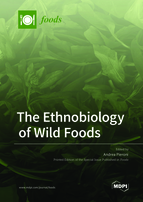The Ethnobiology of Wild Foods
A special issue of Foods (ISSN 2304-8158). This special issue belongs to the section "Food Security and Sustainability".
Deadline for manuscript submissions: closed (20 October 2020) | Viewed by 56965
Special Issue Editor
Interests: food heritage; ethnobiology; ethnobotany; wild food plants; fermentations; neglected species
Special Issues, Collections and Topics in MDPI journals
Special Issue Information
Dear Colleagues,
The ethnobiology of wild foods has received increasing attention in recent years, since traditional foodways around the world are still based on several wild plant, animal, fungal, microorganism, and mineral ingredients, as well as their food products and culinary preparations.
In the last few decades, wild foods in different parts of the world have been the subject of revalorization and commodification processes, with complex outcomes at the social, cultural, and economic level. Within these processes, wild foods have also come under the attention of the tourism and gastronomic sectors, which are bridging innovation and the (re)invention of traditions. Their commodification has, however, sometimes led, in different contexts, to over-harvesting and has threatened the continuation of their use for subsistence.
Wild foods around the globe therefore urgently need to be documented and evaluated, not only in terms of their biological, chemical, technological, nutritional, and pharmacological aspects, but especially in their social, cultural, and religious significance.
Original research on traditional/local wild foods will be particularly welcome, as well as attempts to determine the impact of the survival of these food items for fostering community-centered strategies of local development and sustainable food systems, attuned to local ecologies and cultural heritage.
Prof. Dr. Andrea Pieroni
Guest Editor
Manuscript Submission Information
Manuscripts should be submitted online at www.mdpi.com by registering and logging in to this website. Once you are registered, click here to go to the submission form. Manuscripts can be submitted until the deadline. All submissions that pass pre-check are peer-reviewed. Accepted papers will be published continuously in the journal (as soon as accepted) and will be listed together on the special issue website. Research articles, review articles as well as short communications are invited. For planned papers, a title and short abstract (about 100 words) can be sent to the Editorial Office for announcement on this website.
Submitted manuscripts should not have been published previously, nor be under consideration for publication elsewhere (except conference proceedings papers). All manuscripts are thoroughly refereed through a single-blind peer-review process. A guide for authors and other relevant information for submission of manuscripts is available on the Instructions for Authors page. Foods is an international peer-reviewed open access semimonthly journal published by MDPI.
Please visit the Instructions for Authors page before submitting a manuscript. The Article Processing Charge (APC) for publication in this open access journal is 2900 CHF (Swiss Francs). Submitted papers should be well formatted and use good English. Authors may use MDPI's English editing service prior to publication or during author revisions.
Keywords
- Ethnobotany
- Ethnomycology
- Ethnozoology
- Ethnozymology
- TEK
- Local development
- Gastronomy







